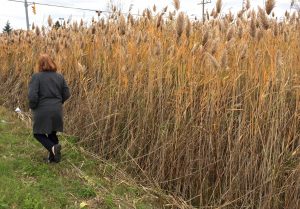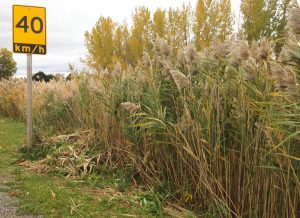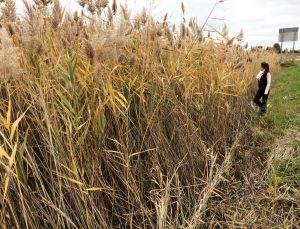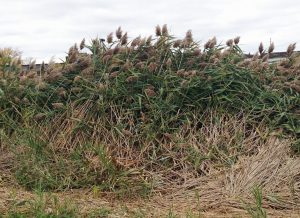By Charlotte McParland [5] and Emilie Quesnel [6]
BELLEVILLE – Phragmites australis [7], one of Canada’s most invasive plant species, is travelling through Ontario along its major highways.
Driving along Highway 401 throughout the Bay of Quinte region and across most of Ontario, you might notice the abnormally tall plants growing along the side of the road. On windy days they can be seen swaying in the breeze.
The aggressive plant has been spotted largely invading the sides of the highway from Port Hope to Kingston, with reports of it reaching as far as the Ontario-Quebec border, and north toward Barrie. The species has also spread to the Great Lakes wetlands in the United States and across North America as far as Nova Scotia.
Also known as the Common Reed, the invasive wet and dry-land plant can reach up to six metres in height. Each seed head from one reed contains at least 2,000 seeds, and the plant releases toxins from its roots that kill or halt the growth of surrounding native plants. This makes Phragmites australis one of the most destructive species in ecosystems.
The plant has been named in 2012 [8] and again in 2015 [9] as the worst invasive species in Canada and was included in this year’s provincial government’s Great Lakes Strategy for 2016 Progress Report [10].
Bay of Quinte conservationist Jane Harris said that the plant “takes over the ecosystems and can completely take over and out-compete other native species for water and nutrients.”
The plant, she added, is “almost impossible to control. It’s becoming a really large problem.”
Other experts says salt from the road seeps into the ditches and stimulates growth. Phragmites originated in Eurasia [11] and thrive in disturbed soil, meaning that as highways are built or expanded, the more the plant will spread through its roots from the seeds.
The seeds can be transferred easily through the mud on excavation tools and vehicle tires.
Belleville resident Cathy Miller said that she has seen the Phragmites across the region and has noticed them more than usual on the sides of roadways.
“I used to see the purple loosestrife everywhere on the sides of the roads because it was so colourful, and now I see this stalky plant everywhere,” she said.
“I drive a lot and it’s definitely started to pop up and become extremely visible these past couple of years. It looks really bad.”
Picton local Regina Thompson has also noticed the plant growing along the smaller roads and in Sandbanks Provincial Park [12].
“Driving along route ON-62 S I’ve started to see them more and more because of their height. I’ve also noticed them spreading in some of the walking paths and near the beach paths at Sandbanks,” said Thompson.
Groups such as the Great Lakes Phragmites Collaborative [13] and the Ontario Invasive Plant Council [14] have created websites and initiatives aiming to spread awareness and help stop the species from ruining wildlife and ecosystems even more.
To help stop the spread of Phragmites, the Ontario Invasive Plant Council recommends that concerned citizens and those enjoying the outdoors brush off clothing after being in contact with the plant to avoid the transfer of seeds, and to not plant or compost the invasive species in any area.
The dangers of this plant, if not stopped from growing, include the loss of habitat, loss of species richness and biodiversity, and increased fire hazards because of the dry stalks.



